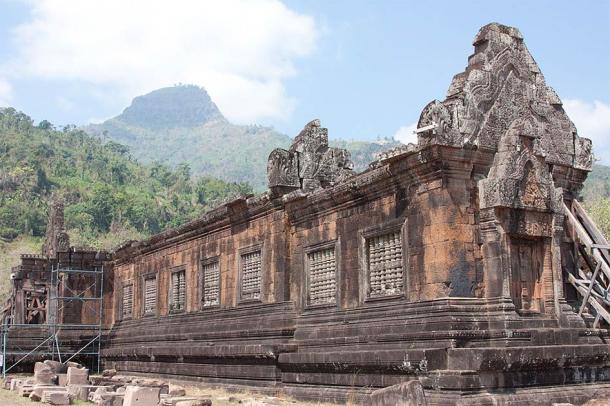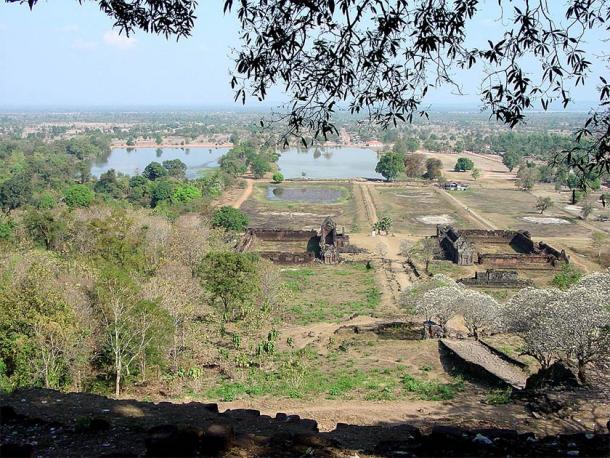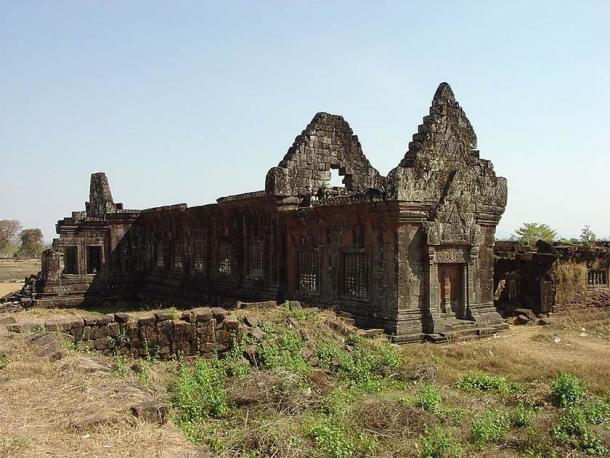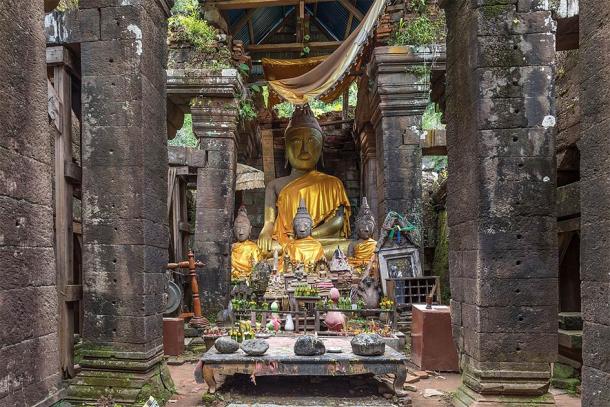The Crocodile Stone is a peculiar rock located in the Vat Phou (also spelled as Wat Phu) Temple complex, in Laos. As its name suggests, the rock contains the carving of a crocodile. More precisely, the shape of a crocodile is impressed into the rock. It has been speculated that in ancient times, the Crocodile Stone was used as an altar for human sacrifices. Although there are some sources that lend support to this interpretation, it cannot be said for certain if human sacrifices were indeed performed on the Crocodile Stone.

Phu Kao Mountain which is shaped like a linga, symbol of Shiva, in the background of the temple complex. (Nick Hubbard / CC BY 2.0 )
The Vat Phou Temple Complex and The Crocodile Stone
The Crocodile Stone is one of the most unusual objects in the Vat Phou Temple complex. This temple complex is located in Champasak Province in southwestern Laos. The Vat Phou Temple complex was built on the west bank of the Mekong River , at the base of the Phu Kao Mountain. In ancient times, the mountain was known as Lingaparvata, meaning ‘Linga Mountain.’ This is due to the fact that the stone formation on the mountain’s peak resembles a linga (or lingam), a pillar-like object that is a symbol of the Hindu god Shiva. Thus, in ancient times, the mountain was thought to be sacred. The religious significance of the Phu Kao Mountain was enhanced by the belief that it represented Mount Meru , the sacred mountain at the center of Hindu cosmology .
The Vat Phou Temple complex was constructed over a long period of time. Most of the structures at the site today were built during the Khmer Empire , i.e. between the 11 th and 13 th centuries. Nevertheless, the site was already used for religious purposes as early as the 5 th century AD. At that time, a Shiva temple stood on the site. In any event, after the Khmers took over the area, they began to rebuild and add to the temple complex.
It has been claimed that Vat Phou may have been the one of the most important Khmer temples, and that early devotees would have taken stones from the site and placed one under every subsequent temple they built. The temple complex continues to amaze even today. It has been argued that the Vat Phou Temple complex is one of the best examples in the world of “the planning and engineering of a landscape that reflects the religious beliefs and economic approaches of both ancient Khmer architecture and the Hindu religion.”
Vat Phou Temple: A Stunning Complex of Intricate Detail
The buildings at the Vat Phou Temple complex were built on several terraces which were aligned along an east-west axis that stretched from the bank of the Mekong River to the foot of Phu Kao Mountain. Visitors who started at the riverbank would first come to two barays, huge water reservoirs that were meant to symbolize the waters surrounding Mount Meru. One of these barays was built at the end of the 11 th century / beginning of the 12 th century. After the barays, the visitors would walk along a long processional road flanked by stone pillars .

The two barays (upper left) at the beginning of the approach to Vat Phou Temple, Laos (Michael Gunther / CC BY-SA 4.0 )
At the end of the processional road stand two large, rectangular stone structures, flanking a 44-meter-wide (144 feet) esplanade. The buildings, constructed on a terrace, each consist of four galleries surrounding a courtyard. In the past, the structures were identified as ‘palaces,’ and were therefore referred to as the North and South Palaces. In more recent times, however, it has been suggested that these buildings were used for ritual purposes, perhaps as places where people could pray for good fortune, or as temporary accommodation for monks during ceremonial periods. Based on the buildings’ architectural style, the two buildings have been dated to the 11 th century AD.

The lower terrace “palace” at Vat Phou Temple (Michael Gunther / CC BY-SA 4.0 )
The esplanade between the two ‘palaces’ continues beyond them and is bordered by regularly spaced stone pillars. Additionally, there were once galleries covered with wood-and-tile roofs on wood pillars. Today, only their foundations remain.
There is also an isolated, rectangular structure to the south of the road. Traditionally, this building, which has pillared porches on its northern and southern sides, is called the Nandi Hall. Scholars are still unsure about its exact function, though it has been speculated that it may have been used to mark the end of the old royal road (known also as the Ancient Road). The Nandi Hall has been dated to the middle of the 11 th century AD.
As one continues westwards along the axis, one encounters more terraces, five more terraces to be exact. Each of these five terraces had some structures on them. On the third terrace, for instance, are a pair of stone pavilions, whereas six small brick towers can be found on the fourth terrace. A linga was placed in each of the towers. As visitors progress from one terrace to the next, they are actually moving higher and higher. By the time they arrive at the sixth and last terrace, they would be 75 m (246 ft) above the two barays that they passed at the beginning of their journey to the temple.
The sixth terrace, which is 60 m 2 square (196.9 ft 2) offers a panoramic view of the entire temple complex, over the plain to the Mekong River, and beyond. In addition, at the center of the terrace is the temple complex’s main sanctuary, which is dedicated to Shiva. To the south of the sanctuary is a small ruined structure referred to as the ‘library.’ Little is known about this structure.
At the back of the terrace is an overhanging cliff, at the foot of which is a spring associated with Parvati, Shiva’s wife. Like Phu Kao Mountain, the spring’s water was also considered to be sacred. Interestingly, the spring was channeled in such a way that its water would flow through the main sanctuary, and over the image of Shiva, which was a sculpted linga.
Although the terraces and their structures along the main axis form the core of the Vat Phou Temple complex, there are several other features of the site that are worth mentioning. The western side of the sixth terrace, just below the overhanging cliff, for example, was once closed by a galleried portico. Although the portico has not survived till the present day, some of its remains can still be seen. The terrace is extended on its northern side by a mountain natural shelf, on which a small modern monastery was build. Further north along this natural shelf are several rock carvings. One of these, for instance, is a footprint of the Buddha on the cliff-face. This is because the Vat Phou Temple Complex was converted into a Theravada Buddhist site during the 13 th century. Animal sculptures, including an elephant and the Crocodile Stone, are also located in this area.

There is controversial speculation that the Crocodile Stone was a place of human sacrifice. (Michael Gunther CC BY-SA 4.0 )
The Crocodile Stone: Used for Human Sacrifice?
The Crocodile Stone is arguably one of the most intriguing artifacts in the Vat Phou Temple complex. Essentially, this is a large stone with a deep impression resembling a crocodile in it. Curiously, a human body could be easily fitted into the stone’s cavity, hence giving rise to the speculation that the object could have been used for human sacrifices. Although is unclear as to when the Crocodile Stone (and the other animal carvings) was created, it is thought to have been made during the post-Khmer period, i.e. after the 13 th century AD. Local legends, however, speak about human sacrifice being practiced before the coming of the Khmers, thus placing the Crocodile Stone in the pre-Khmer period.
A local legend, which has been passed down orally from one generation to the next, claims that human sacrifices were carried out at the Vat Phou Temple complex during the time of the Chenla Kingdom . This kingdom was once a dependency of Funan, a state that dominated the southern part of mainland Southeast Asia from the 1 st to the 6 th centuries AD. Following the decline of Funan, the Chenlas were able to create an independent state. Little is known about the Chenla Kingdom, but they are considered to be the predecessors of the Khmer Empire.
In any case, according to the local legend, once a year, the king of Chenla would sit on the main causeway of the Vat Phou Temple complex and pray to the spirits of the mountain for their blessings and protection in the coming year. In return, human sacrifices were made to these spirits, so as to appease them. Two girls were selected for their beauty, given rice wine, and sacrificed. These rituals took place when the frangipani petals started falling. Based on this story, it is speculated that the Crocodile Stone was the site where this annual human sacrifice took place.
The story of human sacrifices performed by the Chenlas seems to be corroborated by a Chinese text, the Sui Chronicles , which was written during the 6 th century AD. According to this source, the kings of the Chenla performed human sacrifices to Bhadreshvara, a form of Shiva. This Chinese account, however, notes that the sacrifices took place on the top of the Phu Kao Mountain, rather than at the site of the Crocodile Stone.
Whilst local legend and the Sui Chronicles indicate that human sacrifice was practiced by the Chenla Kingdom, they make no reference at all to the Crocodile Stone. In addition, the artifact itself contains no further evidence to indicate that it was used as an altar for human sacrifices. The mystery is deepened by the fact that no artifact resembling the Crocodile Stone has ever been found either in Laos or in neighboring Cambodia, both of which were once part of the Chenla Kingdom and the Khmer Empire. It has also been pointed out that while crocodiles exist in the region, they do not seem to have had any religious significance. This raises further questions about the actual meaning of the Crocodile Stone in the Vat Phou Temple Complex.

Clothed statues of the Buddha seated, table with stones and Buddhist relics, at the center of Vat Phou Temple. (Basile Morin / CC BY-SA 4.0 )
Vat Phou Temple Loses Its Status But Remains Popular
As mentioned earlier, the Vat Phou Temple complex was turned into a Buddhist site during the 13 th century AD and was no longer part of the Khmer Empire after that same century. During the 14 th century, a new power, the Kingdom of Lan Xang, was established. This kingdom is considered to be the predecessor of modern-day Laos. Under the Kingdom of Lan Xang, Champasak lost its status as an important and prosperous province. Instead, it was an area on the border of the kingdom, and therefore fought over by different powers. This meant that the Vat Phou Temple complex also lost its national significance. Nevertheless, the temple complex continued to be an important religious site amongst the locals, and still is even today. For instance, the annual Vat Phou Festival is held during the full moon in February. It is claimed that this is the largest festival in southern Laos, and it attracts many visitors to the site.
Although the Vat Phou Temple complex continues to function as a religious site, it has not been thoroughly studied by scholars yet. Archaeologically speaking, for instance, only about 5% of the site has been excavated. This means that the development of the site over the centuries is still not fully understood. Apart from that, little restoration work has been done on the structures at the Vat Phou complex in modern times. Such works would have afforded scholars an invaluable opportunity to learn more about the site and its buildings.
In 2001, the Vat Phou Temple complex became a UNESCO World Heritage Site, as part of the ‘Vat Phou and Associated Ancient Settlements within the Champasak Cultural Landscape.’ In addition to the Vat Phou Temple complex, this World Heritage Site also includes Phu Kao Mountain, the Ancient Road, as well as several other temples.
In order to increase the number of tourists visiting the temple complex and its surroundings, a new highway, which connected the site to Pakse, the regional capital, and to the Thai border post of Chong Mek, was built.
As a World Heritage Site, the Vat Phou Temple complex and its surroundings are protected from modern development, as building without assessment and approval is not allowed. Nevertheless, other ancient monuments are being threatened. A report from 2011 claimed that during the construction of the highway, six ancient temples beneath the ground were disturbed. The construction work was not halted in order to study the finds. The report also mentions that the authorities hope to extend this road to the Cambodian border, and that land along the highway has been partitioned for infrastructure, such as entertainment complexes and restaurants. These actions would certainly pose more threats to any archaeology in the area that may be discovered.
Top image: The Crocodile Stone of Vat Phou Temple, Laos. Source: Mattun0211 / CC0
By Wu Mingren
References
cne, 2020. Dark History: Human Sacrifice, Black Magic & Cannibals. [Online]
Available at: https://cne.wtf/2020/02/22/dark-history-human-sacrifice-black-magic-cannibals/
Cortesi, M., 2020. Crocodile Stone. [Online]
Available at: https://www.atlasobscura.com/places/crocodile-stone
Lao PDR, 2000. Nomination of Vat Phou and Associated Ancient Settlements within the Champasak Cultural Landscape. [Online]
Available at: https://whc.unesco.org/uploads/nominations/481.pdf
Lonely Planet, 2020. Wat Phu Champasak. [Online]
Available at: https://www.lonelyplanet.com/laos/wat-phu-world-heritage-area/attractions/wat-phu-champasak/a/poi-sig/1341560/1314809
Messeri, B., 2008. The Spirit of the Place During the Life of a Monument in the Case Study of World Heritage Site as Vat Phou (Laos). [Online]
Available at: https://www.icomos.org/quebec2008/cd/toindex/77_pdf/77-pgXV-142.pdf
New World Encyclopedia, 2020. Wat Phou. [Online]
Available at: https://www.newworldencyclopedia.org/entry/Wat_Phou
Tyler, L., 2011. Vat Phou temple’s ancient history. [Online]
Available at: http://www.stuff.co.nz/travel/international/5800903/Vat-Phou-temples-ancient-history
UNESCO, 2020. Vat Phou and Associated Ancient Settlements within the Champasak Cultural Landscape. [Online]
Available at: https://whc.unesco.org/en/list/481/
www.aboutasiatravel.com, 2020. Chenla Kingdom. [Online]
Available at: https://www.aboutasiatravel.com/cambodia/history/chenla-kingdom.htm
www.insideasiatours.com, 2020. The History of Cambodia. [Online]
Available at: https://www.insideasiatours.com/southeast-asia/cambodian-culture/history/
www.renown-travel.com, 2020. Wat Phou. [Online]
Available at: https://www.renown-travel.com/laos/pakse/wat-phou.html
www.southern-laos.com, 2020. Vat Phou Temple a World Heritage site. [Online]
Available at: https://www.southern-laos.com/travel-directory/vat-phou-temple-a-world-heritage-site/
 RSS Feed
RSS Feed















 July 30th, 2020
July 30th, 2020  Awake Goy
Awake Goy  Posted in
Posted in  Tags:
Tags: 













